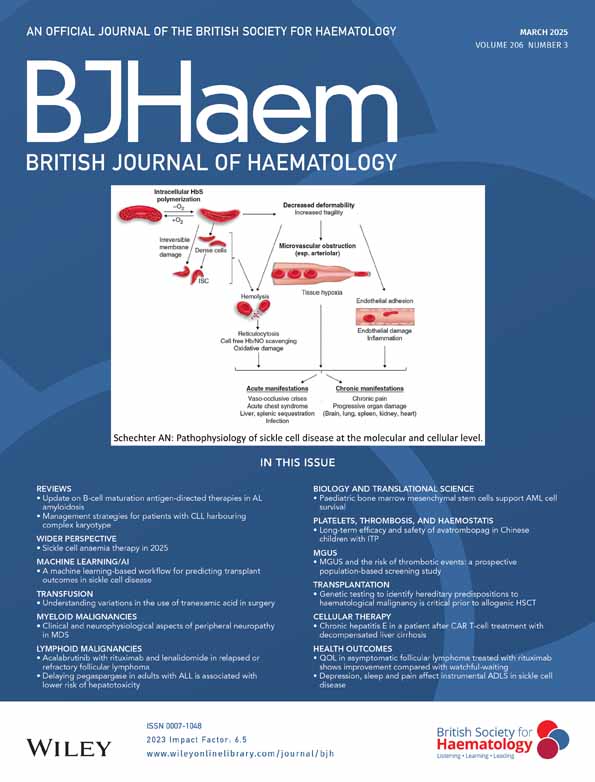Neurophysiological markers in myelodysplastic syndromes: Insights into peripheral neuropathy
Abstract
In their paper, Papantoniou et al. present relevant findings on the prevalence and characteristics of peripheral neuropathy in patients with myelodysplastic syndromes (MDS), underscoring the necessity for a more nuanced understanding of neurophysiological involvement in this complex haematological disorder. Their study not only reveals a higher frequency of neuropathy in MDS patients than previously reported but also illuminates specific neurophysiological patterns that may redefine clinical expectations and diagnostic practices in MDS-associated peripheral neuropathy.
Commentary on: Papantoniou et al. Clinical and neurophysiological aspects of peripheral neuropathy in patients with myelodysplastic syndromes. Br J Haematol 2025; 206:864-867.
Traditionally, MDS has been characterized by dysplastic haematopoiesis and chronic cytopenias, while its autoimmune and inflammatory manifestations have received less attention.1 Among these, peripheral neuropathy has been observed only sporadically, typically reported with a prevalence between 1.8% and 4.3% in smaller, isolated studies.2-5 In their paper, Papantoniou and colleagues document peripheral neuropathy in 50% of their MDS cohort, signalling a substantial shift in our understanding of its prevalence.6 They systematically evaluate both large and small nerve fibre involvement, revealing a symmetric, length-dependent axonal loss without demyelination, which points away from an inflammatory aetiology. The symmetrical length-dependent nature of axonal involvement suggests a primary axonal degeneration rather than a secondary autoimmune demyelination.7 This pattern aligns with findings from neurophysiological assessments, including decreased sural SNAP amplitude and intraepidermal nerve fibre density (IENFD) in skin biopsies from patients with neuropathy, with significant reductions compared to controls. These insights contribute to a developing profile of MDS-related neuropathy, where the involvement of both large and small fibres might indicate a broader systemic impact of MDS on the peripheral nervous system.
Papantoniou et al. employ a rigorous neurophysiological approach, integrating nerve conduction studies (NCS), quantitative sensory testing (QST) and skin biopsies to provide a comprehensive analysis of neuropathy in MDS. This multi-modal evaluation is critical in accurately diagnosing both large fibre neuropathy (LFN) and small fibre neuropathy (SFN), conditions often underdiagnosed due to limitations in clinical or single-modality testing.8 Their use of consistent NCS parameters across key nerves in the upper and lower extremities allows for a robust characterization of nerve function and distinguishes sensory from sensorimotor neuropathies among patients. The incorporation of QST adds depth to their evaluation, assessing cold and heat detection thresholds, which are critical for diagnosing SFN, a condition that can elude traditional NCS.8 The study's findings that MDS patients exhibit significantly elevated heat detection thresholds and reduced IENFD suggest that SFN is a prominent feature of MDS-associated neuropathy, although it often coexists with LFN. This dual involvement underscores the systemic nature of MDS and may imply a more widespread, underlying neuropathic process that warrants further exploration.
The implications of this study are far-reaching. By identifying peripheral neuropathy as a relatively common feature in MDS, Papantoniou et al. prompt clinicians to consider neurophysiological assessments as part of routine evaluation in MDS patients, particularly those with high International Prognostic Scoring System (IPSS-R) scores or longer disease durations, both of which correlated with neuropathy in this cohort. Given that neuropathy in MDS can remain asymptomatic or present with non-specific symptoms like numbness or gait instability, early screening could facilitate timely diagnosis and intervention, potentially improving patient quality of life. The absence of demyelinating features in NCS findings, coupled with symmetrical axonal loss, suggests that the pathogenesis of neuropathy in MDS may diverge from classic autoimmune neuropathies.9 Papantoniou et al. speculate that neuropathy in MDS could be attributed to a paraneoplastic process, possibly triggered by the systemic immune dysregulation inherent to MDS. Future research into the molecular mechanisms behind MDS-associated neuropathy could clarify whether similar paraneoplastic processes are at play, paving the way for targeted therapies.
While Papantoniou et al. make a compelling case for the re-evaluation of neuropathy in MDS, their study is not without limitations. The relatively small sample size and single-centre design limit the generalizability of their findings. Moreover, technical constraints prevented skin biopsies in all patients, which may have led to underreporting of SFN cases. Future studies with larger, multi-centre cohorts could address these limitations, providing a more representative understanding of neuropathy prevalence across MDS subtypes and treatment regimens. Additionally, their finding of a lack of correlation between 5-Azacytidine therapy and neuropathy incidence deserves further exploration. As 5-Azacytidine is a common treatment for MDS, understanding its potential neurotoxic effects—or lack thereof—could influence therapeutic decision-making in MDS patients at risk for neuropathy. Longitudinal studies examining neuropathy progression relative to treatment duration and intensity would be valuable in clarifying this relationship.
Papantoniou et al. have delivered a significant contribution to the field of haematology with their exploration of peripheral neuropathy in MDS, challenging existing assumptions about its prevalence and pathophysiology. Their findings advocate for the inclusion of neuropathy screening in MDS management protocols and underscore the importance of comprehensive neurophysiological testing. As we continue to unravel the complexities of MDS, studies like this one remind us that understanding its systemic manifestations, including neuropathy, is essential to improving patient care and quality of life.
ACKNOWLEDGEMENTS
Open Access funding enabled and organized by Projekt DEAL. [Correction added on 26 November 2024, after first online publication: Projekt DEAL funding statement has been added.].




